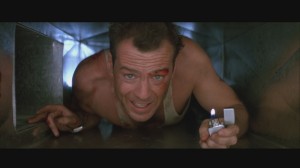Hollywood has done an excellent job of defining what it takes to be an action hero. George Smiley, the grey civil servant of John Le Carre’s spy novels, is a protagonist, but not a hero. Heroes are cast in a distinct behavioral pattern. Bruce Willis, Mel Gibson, and Harrison Ford characters represent the archetype I’m describing.
We use the DISC behavioral profiles with all of our clients. Perhaps we shouldn’t be surprised that the factors that make a Hollywood hero also appear in many of the business owners we work with. The question is; do Hollywood action heroes make good entrepreneurs? Consider the action hero behavioral profile.
High D. The high Dominant personality solves challenges by overcoming them, as opposed to circumnavigation. A high-D entrepreneur takes things head on, and seeks immediate results. Action is usually more important than direction. Think about Harrison Ford’s Indiana Jones. When told that the Ark of the Covenant is on a truck to Cairo, he grabs a horse. Is that the best plan for catching a truck? Probably not, but it is the first action available.
 High I. The high Influencer uses language and verbal communication to influence those around him. John McClane, the cop from Die Hard, never shuts up. He rails at the cops, at the villain, at himself, and even maintains a running commentary while he is fighting for his life with the bad guys.
High I. The high Influencer uses language and verbal communication to influence those around him. John McClane, the cop from Die Hard, never shuts up. He rails at the cops, at the villain, at himself, and even maintains a running commentary while he is fighting for his life with the bad guys.
Low S. The Steadiness measurement indicates a tendency towards planning, teamwork and supportiveness. Martin Riggs, Mel Gibson’s character in Lethal Weapon, is a typical loner hero. While he has personal loyalty to his partner, that loyalty isn’t sufficient to keep him from getting them both into trouble regularly, something he does without consulting Murtaugh, and often despite his partner’s protestations.
Low C. The Compliance factor relates to how well you follow the rules. The low C hates the rules; they merely handcuff his ability to act. There are hundreds of examples. “You can take my badge, you can take my gun (I have another- which is of course against the rules), you can take me off the case, you can revoke my 00 license to kill, but you can’t stop me from doing what I think I need to do.”
The low-C also refuses to consider risk in his decision process. Consider Han Solo’s response to C3PO’s calculation of the probability of surviving a flight through an asteroid field. “Never tell me the odds.”
Have I described any entrepreneurs that you know? Of course I have. It takes action, focus, fast talking and usually some risky decisions to start a small business. The problem arises when the action hero entrepreneur becomes successful. Taking your organization beyond the “Army of One” phase requires a different set of behaviors. Those who don’t adapt find themselves stuck at their maximum personal capacity, and can’t bring their organizations to the next level.
James Bond will never get M’s job. Han Solo may marry Princess Leia, but he will never sit next to her in planning meetings. At last count, Martin Riggs and John McClane have been stuck at the same detective pay grade for eleven and nineteen years respectively.
In Jim Collin’s Good to Great (in my opinion one of the three best business books ever written), he talks about the level 5 leader. The level 5 goes beyond the cult of personality, leading with a steady hand and singular focus on long term improvement.
That may work in large organizations, but it’s far more difficult in an owner-run small business. When every employee sees the owner each day, he or she has to exhibit substantial charisma and verbal influence. If you want to grow to an organization where the employees perform without seeing you every day, however, you will need to be more than an action hero.

2 Responses to An Army of One